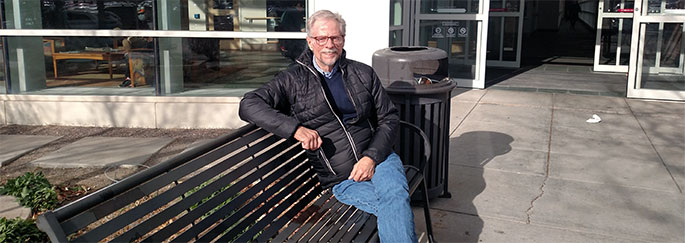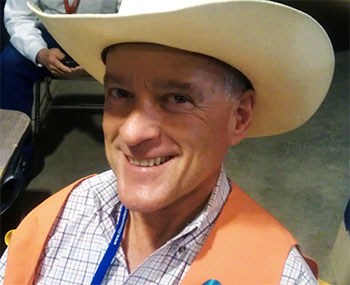AIDS Clinical Trails Unit Saving Lives
CU offers experimental treatments and hope to patient volunteers

By Debra Melani
(May 2018) When he tested positive for HIV in 1991, David Dillon was certain he received a death sentence.
He’d watched friends die, struggling with intense side effects caused by the only drugs available at the time, medications that were barely effective on the AIDS virus, which could adapt, often within months, to build resistance to them.
Dillon found hope in the words of a social worker, who told him that experts were on the verge of turning the deadly affliction into a chronic but manageable disease.
“That’s what I grabbed on to right away,” Dillon said. “And that’s what I’ve hung on to ever since.”
Dillon was one of the first HIV-positive patients to volunteer for studies with the Colorado AIDS Clinical Trials Unit (ACTU), now part of the University of Colorado Anschutz Medical Campus. Today, as the ACTU celebrates 25 years of major contributions in revolutionizing HIV/AIDS treatment, Dillon is alive, grateful to the CU team that helped him, and he’s confident that he helped make a difference.
Recruiting a leader
CU established itself as a center for HIV/AIDS research in 1990 by recruiting Robert Schooley, MD, a Harvard Medical School professor
At Harvard, Schooley’s research group was among the first to delineate the humoral and cellular immune responses to HIV infection. He also was involved in the discovery and development of antiretroviral chemotherapeutic agents including reverse transcriptase inhibitors, protease inhibitors
“It was a big deal,” Thomas Campbell, MD, who was an infectious disease fellow at CU at the time and is now principal investigator of the Colorado ACTU. “I remember sitting on my back porch and reading about his recruitment on the front page of The Denver Post. Bringing him to Colorado was like recruiting John Elway to the Denver Broncos. It’s bringing a superstar to Colorado, which helps elevate the whole team.”
At CU, Schooley established the AIDS Clinical Trials Center, bringing experimental drugs to the region. While at CU, Schooley was elected to serve as Chair of the National Institute of Allergy and Infectious
CU’s unit joined a growing number of national sites within the AIDS Clinical Trials Group (ACTG), initially formed in 1987, as the urgency for new drugs intensified.
“Schooley was the key person that made that happen, and so all of the great HIV/AIDS research capacity that we have today is largely possible because of the groundwork that he laid and the foundation that he built in the early ’90s,” said Campbell, who is now medical director of the University of Colorado Hospital Clinical and Translational Research Center of the Colorado Clinical and Translational Sciences Institute.
Dillon’s many trials
Schooley’s arrival at CU may have saved Dillon’s life.
In 1991, Dillon was an employee in the CU Boulder housing department and just learning of his infection. He wore a beeper that every four hours reminded him to take his pills. While he didn’t suffer side effects as
Dillon found Graham Ray, RN, who is still a study coordinator with the Colorado ACTU, and signed up for one of its first clinical trials. The study involved spending some nights in the hospital, and Dillon recalled a trial patient in a nearby bed.
“He had pretty much run the gamut of drugs available. He’d run out of options, so this trial was one of his last hopes,” Dillon said. “I lost several friends that were in the same boat. There just wasn’t new treatment coming fast enough to help them.”
“Few drugs and rapid resistance were major problems for patients in those days,” Campbell said. “We could only give one or two drugs at the most together, and drug resistance developed very rapidly. The medicines lost their effectiveness.”
For Dillon, who estimates he has tried as many as 20 single experimental drugs, the trials always came right in time, with Ray and his CU doctor, Steven Johnson, MD, professor of medicine in the Division of Infectious Diseases, regularly alerting him to new studies.
In its 25 year history, the Colorado ACTU has conducted more than 177 clinical trials, with more than 2,500 participants coming forward to help scientists and providers in their search for a more effective treatment.
“It just seemed like I was already right at the cusp, so when a drug came into testing, I was ready for it,” said Dillon, now 65, who still travels to the Anschutz Medical Campus from his Loveland home. “Dr. Johnson saved my life more than once.”
HIV attacks patients’ immune systems by binding to and killing CD4 cells, which are white blood cells that fight infection. Doctors monitor CD4-cell counts to assess the progression of the disease. A normal CD4 count is between 500 and 1,400 cells per cubic millimeter of blood. At levels below 200, patients are at high risk of developing serious illnesses. Dillon’s counts were once as low as five.
Trial participants are part of a mission
For Patrick Terry, a Denver-area native who has done “probably a dozen” trials since 2000. Because of his dedication to the trial process, he calls himself a go-to volunteer for ACTU research nurse Cathi Basler, RN. Taking part in trials is about staving off AIDS (his CD4 count has never fallen below 500), and putting an end to the epidemic.
“To me, it’s so important that we find out more about it,” Terry said, “and if there’s any chance that there could be a cure, then I’d like to be a part of it.”
Both Dillon and Terry acknowledge that helping science isn’t always easy. But their perseverance has paid off, for them, and for many of the more than 30 million people worldwide living with HIV.
While Dillon said he feels “lucky” because he’s apparently always received the active drug in the double-blind studies, he recalled a nearly five-year trial that required injecting a drug in his abdominal muscles twice a day. “It just hurt, and you had to just keep doing it.”
“You know when you are on the real drug,” said Terry, 60, who began volunteering for clinical trials after being diagnosed with HIV in 1995. “I’ve had some very difficult studies,” he said, noting one in which the drug was so strong, it caused
Sticking with the treatment
In 1996, a Colorado ACTU-led research study played a key role in the development and widespread use of what was commonly termed “drug cocktails.” That was a major turning point in HIV/AIDS treatment, Campbell said.
“When we first really had the ability to put three drugs together to make an effective combination, it greatly reduced the risk of drug resistance. It did so by having much more effective suppression of viral replication,” he said. “We suddenly had a way to effectively treat HIV and prevent all the damage it does to the body.”
Currently part of a two-drug combination trial, Terry’s CD4 counts hover around 1,000, and his viral load is undetectable. For Dillon, although his CD4 counts aren’t quite as high, and his “cocktail” includes five drugs, his viral load is also undetectable.
Terry emphasizes that the effective drugs are still not a cure and he advocates for medication adherence. “I’ve never missed a dose, and that’s probably one of the most important things,” said Terry.
“Take it seriously,” Terry said. “Don’t skip your medicine. That’s a problem with so many people. The medicine doesn’t work if you don’t take it. And take care of yourself,” he said.
Researchers still have work to do
While noting significant progress in treatment, which would not have been possible without dedicated volunteers, Campbell, also emphasized that HIV remains a serious virus with no cure.
“Yes, a person diagnosed today who seeks treatment early and adheres to it should live a near-normal lifespan,” Campbell said. “But near normal is not normal. There’s still a lot of work that needs to be done.”
Dillon said he’s grateful for that first social worker’s hopeful words and for finding the Colorado ACTU. “It saved my life, and it saved a lot of other lives.”